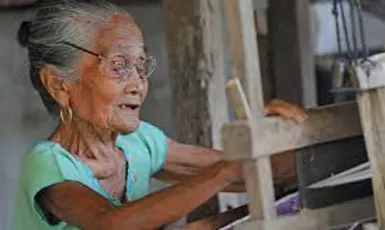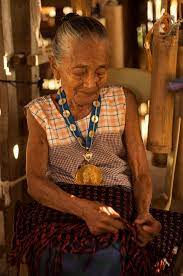
LIFE
Born August 13, 1924
AT 16
Magdalena Gamayo learned the art of weaving from her aunt at a young age of 16. Even without receiving formal training on weaving, she was able to master the art by herself by copying design patterns. At that age, every girl in her village knew how to weave. There would be an informal competition among her cousins and friends when it comes to the consistency and fineness of weaving.
FIRST LOOM
At the age of 19, Magdalena acquired her first loom. Her father secured the sag’gat or hardwood himself and gave the task of creating the loom to a local craftsman. Her first loom lasted for 30 years. It has been with her all throughout her years of marriage and motherhood, supporting her financially. When the time came that she had to replace her loom as it was beyond repair, she thought of herself as lucky to have been able to buy a secondhand one.
TEACHING
Today, Magdalena has her cousin’s daughter-in-law and sister-in-law as her students. Her cousin’s daughter-in-law moved to Magdalena’s community after marrying into Magdalena’s family. On the other hand, her sister-in-law learned how to weave at the age of 38. She has also had other students before them. She primarily teaches them triple-toned warp binakol. When satisfied with the quality of their output, Magdalena then teaches them other kinds of patterns or designs.
AT 88
Magdalena’s age does not hinder her from making one-of-a-kind creations which only proves how machines will never be able to match human art. Her eyesight still holds true and she still takes care of arranging the threads on the loom. Some of the traditional patterns that Magdalena has taught herself include binakol, inuritan (geometric design), kusikos (spiral forms similar to oranges), and sinan-sabong (flowers), which is the most challenging pattern. She has also taught herself to recreate designs by only being able to see the design.
Magdalena's work is finer than most abel - her blankets have a high thread count, and her designs are the most elaborate, using up to five colors in some cases. Her designs are stunning because of how delicate and uniform her patterns are. (ncca.gov.ph)

Loom
There are few locals who have the skills to put together a loom similar to the ones Magdalena uses: a sturdy wooden frame with three-foot pedals with wide horizontal beams to support the warp and an even longer lengthwise frame to keep the threads in place. It is different from the backstrap loom traditionally used in the Cordillera, where the warp is anchored to a stationary object on one end and to the weaver’s body on the other end. (ncca.gov.ph)
.png)














